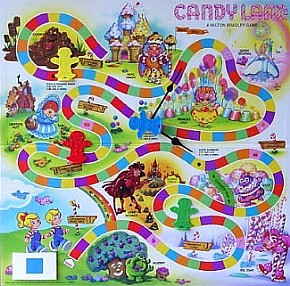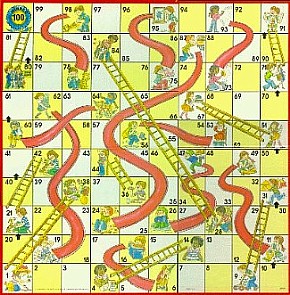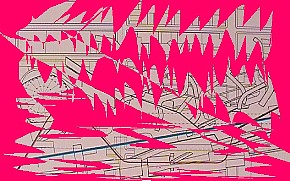1998.01.04
notation of existing Campo Marzio texts - Tafuri 2
Here are more Tafuri descriptions of the Ichnographia of the Campo Marzio as found in The Sphere and the Labyrinth:
a. a fully developed and articulated metaphor of the machine-universe.
b. polemical and self-critical.
c. a formless heap of fragments colliding one against another.
d. a formless tangle of spurious organism.
e. a homogeneous magnetic field jammed with objects having nothing to do with each other.
f. a kind of typological negation.
g. an "architectural banquet of nausea."
h. a semantic void created by an excess of visual noise.
i. a virtual catalogue
j. a typological sample book.
1998.01.07
more texts from Tafuri 2
"And thus the cause of the "decline and fall" is one alone--the loss of republican freedoms and the advent of a laxist aristocracy. The Piranesian "labyrinth" begins to give itself a political significance, cleverly disguised.
The ambiguity of the Campo Marzio now becomes evident; it is at once a "project" and a denunciation. As a disenchanted documentation of the impossibility of an unambiguous definition of language, it--projecting this situation into the past--sounds like a merciless satire of the infinite capacity of late-baroque typology to reproduce itself metamorphically. (The fact that in the Campo Marzio the allusion to baroque typologies is filtered through a classicist geometrism fools no one; it is simply a means of rendering metahistorical and universal the polemic already begun.) Inasmuch as it is--despite everything--an affirmation of a world of forms, the Campo Marzio, precisely because of the absurdity of its horror vacui, becomes a demand for language, a paradoxical revelation of its absence.
Negation and affirmation cannot split apart. The "naīve dialectic" of the Enlightenment is already superseded.
The "great absentee" from the Campo Marzio, then, is language.
The absolute disintegration of formal order, of what remained of the huminist Stimmung, of its sacred and symbolic values--and, above all, of perspective as a symbolic instrument for the quantitative control of space--logically also affects the subject of Piranesi's work: the relationship between history and the present. On one side, there is painstaking , scientific study of archeological findings; on the other, the most absolute arbitrariness in their resolution. (In this respect, after all, the Campo Marzio is anything but an exception in Piranesi's work.) History no longer offers values as such. Subjected to a merciless inspection, it is revealed as a new principle of authority, which as such must be disputed. It is the experience of the subject that establishes values; in this, already lies all the aspiration to the negative polemic of romanticism. Is Piranesi the "archeologist" interested in caves, underground passages, and substructures purely by chance, then? Rather, cannot this interest in "what is hidden" in ancient architecture be interpreted as a metaphor for the search for a place in which the exploration of the "roots" of the monuments meets with the exploration of the depths of the subject?
Manfredo Tafuri, The Sphere and the Labyrinth - Avant-Gardes and Architecture from Piranesi to the 1970s (Cambridge: The MIT Press, 1987), p. 38.
| |
1999.07.13 22:52
the pleasure of (being lost in translation) architecture
My favorite: The configuration enters another one is connected with the both.
1999.07.29 14:28
crypto-architecture
Generally, Bloomer's treatment of Piranesi's Campo Marzio follows that of Tafuri's, but she investigates some of Piranesi's other work with some originality. She is much better at finding symbolism/hidden meaning in Joyce, however, than she is in finding the same in Piranesi. For her, the (s)crypt(s) signifies a labyrinth (one she often seems lost in herself, even though it is a labyrinth of her own making!). For example, she sees the Campo Marzio plan as representing the labyrinth of the underworld, that place where the [Cartesian] grid/cage of rationality does not apply. Her [s]cryptic efforts getting into this underworld are especially worth reading because it is a thorough aggregate of good research mixed (unfortunately?) with the Tafurian and Derridian agendas (see her treatment of the CM's Terentus occulens aram Ditis et Proserpinae). Inadvertently, however, by going 'underneath' the large plan, she puts all her effort into seeking something that is not there. Essentially, she avoids the real plan itself.
2001.04.04
a real puzzle
...generate a real puzzle of a large plan, essentially providing pieces of an Ichnographia. ...each piece of the puzzle will be an image map containing links to other pages which can be text, clues, or just archived pages. These "background" pages could be very serendipitous and even abstruse and even labyrinthine in that they could offer links to ever deeper (obscure) pages.
2007.02.07
meaning of labyrinth, etc.
I remembered last night that I recently read a good explanation of labyrinth (vis-ā-vis architecture) and then thought how it relates to Piranesi's Campo Marzio plan, or at least how the labyrinth relates to some of the interpretations of the Ichnographia. I now think the passages read was within L.B. Alberti's Hypnerotomachia Poliphili.
"Along with incomprehensible epigrams and inscriptions, unknowable animals and humans, the Hypnerotomachia is full of obscure, dark, intractable places: forests, veiled entrances, labyrints. Indeed, the labyrinth--a kind of emblem of hermetic difficulty, the symbol par excellence of search and the abstract model for most kinds of problem-solving activities--marks almost every step of the hero's wanderings as he makes his way through the story. As early as the first chapter, the reader follows the hero through a forest as he exclaims, "I had as my only recourse to implore the pity of the Cretan Ariadne, who gave the thread to Theseus to get out of the difficult labyrinth." Readers are constantly finding themselves within labyrinths: one inside the viscera of the temple at the base of the pyramid; an aquatic one in the form of a circular, maze-like pool; the concentric-patterned garden on the island of Cythera; and the subterranean spaces under a landscape of ruins."
"The book itself is a labyrinth, a series of veils, a cryptic epigram."
Liane Lefaivre, Leon Battista Alberti's Hypnerotomachia Poliphili, pp. 90, 91.
| |
"A post about empty spaces - or lack of - feels like a suitable place to put Quondam, Stephen Lauf's epically impenetrable 'online collage', a real labyrinth of a website. Here, for example, you'll find information on the First Virtual House of the 20th Century, Robert Venturi's Franklin Court. Not just an empty room, but an empty house."
2009.02.21 18:20
Bilocation Syndrome
Yes, museum as eternal wrest
Qtherwise, think of it as

meets

meets

| |
2009.02.25 13:12
Re: Recent book
Dictionary of Literary Themes and Motifs (1988)
It describes/explains about 200 themes and gives examples of where they appear throughout literature. E.g., Incubus and Succubus, Jealousy, Labyrinth, Lameness, Language, Laughter... So far I read 'Labyrinth' and it's neat how it is both informative and inspiring and gives you leads into other territories to explore.
2009.03.08
journal
Started the process of coordinating the Philadelphia model with IQ. Right now the priority is to bring each section up to the level of completeness a la the data existing thus far. This seems to be the right way to go for Quondam because all the various model data of the entire collection will have a three dimensional place. No doubt this will all be a lot of (drone) work, and I hope it will be worth it, as in something worthwhile architecturally will be gained.
But what is this all really about? It does have to do with "using" the museum, and also using history, specifically architectural history.
Other things going on are:
1. reading A Skeleton Key to Finnegans Wake and seeing how it actually does relate to the ICM, (at least to my interpretation of the ICM). I may ultimately have to read all of Bloomer's Architecture and the Text to make sure I just didn't get her point back them just because I just didn't know any better (about Finnegans Wake).
The other interest in Finnegans Wake is because of the labyrinthine "design" and how I now want to understand and manipulate Quondam as a labyrinthine design. My feeling is that Quondam already is a labyrinth and now I just want to understand and design it better.
2. I want to also employ Quondam as an outlet for architectural fiction, and, right now, the theme of Quondam's architecture fiction is Quondam itself and the buildings in its collection are the novel characters. For what it's worth, I just thought of the Houses for Otto as "ancient" ruins where there are foundational remains but nothing else--we don't even really know if they are/were even houses. (And now I'm seeing how this is very much how Piranesi operated within the ICM and the earlier plans.) In any case, the narrative at Quondam derives from the stories that each building or buildings present.
2009.06.06 20:18
how about thom mayne?
Quondam is my site. It's the first virtual museum of architecture, online since 21 November 1996. Earlier this year thingsmagazine.net described Quondam as "Stephen Lauf's epically impenetrable 'online collage', a real labyrinth of a website," and that suits me just fine.
Yes, Quondam is dense, and even I don't know where everything is, so I utilize site-specific google searches to find things.
The numbering system has no meaningful significance beyond its sequentiality; file names, that's all.

The specific image you ask about also has no intended significance in terms of how Thom Mayne may see things, but, as you've now demonstrated, it is capable of inspiring a significance. And that's more or less the point...
| |
2009.06.12 08:36
please comment or destroy, thank you
"In German, a mnemonic can be fashioned from the literal meaning of the Latin word complicare. which means "to fold together (zusammenfalten)": the complicated, then, can be rendered graspable via unfolding (Entfaltung), because it thereby becomes simple (einfach) in a sense of naīve or ingenuous (einfältig). But the Latin word complexus means "mutual embrace," or, so to speak, the labyrinthine [emphasis added], the convoluted: here, simplicity already contains within itself the seed of all the complexity that comes to appearance through its own development. In cases of doubt, then, the complicated can be profitably reduced and simplified--but the complex, in contrast, cannot be simplified with impunity. To say that something is complicated means that the finite number of its determinations cannot be grasped directly. To say that something is complex means, by contrast, that the number of its determinations is simply infinite."
Clemens Bellut, "Ach, Luise, lass ... das ist ein zu weites Feld," or: The Gordian Knot of Complexity" in Complexity: Design Strategy and World View (2008).
Eternal Wrest ... really only the beginning?
"All the world's a next stage."
2009.07.14 20:38
inspiring Maya Linked Hybrid edge
...the Athenian master craftsman and inventor, Daedalus, was given a commission by King Minos of Crete to build a labyrinth, a prison for the man-bull monster, the Minotaur. Later, Minos imprisoned Daedalus and his son, Icarus, in the labyrinth. The two escaped on wings made by Daedalus of wax and feathers, but Icarus flies too close to the sun, his wings melt, and he falls into the sea.
remembering "journey motifs"
2009.09.30 21:33
Information Architects Talking About Architects and Architecture
Presently, I like to design delivery of content in the enfilade slash labyrinth style.
Perhaps, someday, I'll design some delivery of content following the architecturale promenade formula.
Actually, I've been struggling with a big design/renovation brief, the solution to which has been eluding me for well over a month now. Alas, today, while just stepping out of the shower, it finally dawned on me--delivery of content in the enfilade slash labyrinth style via bilocation.
Is subtext actually text bilocated?
|



